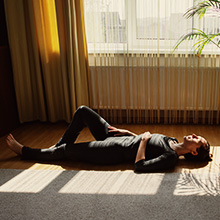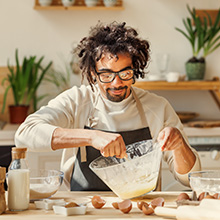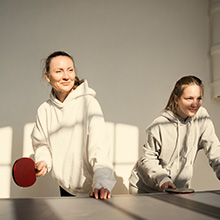Anne loves gardening. After a day of work, she heads straight to the backyard
“As I water the flowerbeds, planters and hanging baskets, I wash away the stresses of the workday, she says. I breathe in the scent of roses and peonies and my heart rate slows. My shoulders unwind as I pull some weeds. It doesn’t take long before I feel way more relaxed.”
Gardening can do more for you than give you pretty flowers or healthy vegetables. It’s also great for your head, your heart and your wallet. Here’s how.
Can gardening save you money?
In a word, yes. If you have the space, homegrown raspberries, rhubarb and other produce can cost much less than store-bought.
And their just-picked flavour is unbeatable. You also know exactly what chemicals have and haven’t been used on them.
Growing herbs offers the best cost savings. You can save roughly $3 when you snip a few sprigs of herbs rather than buying a whole bunch. Not to mention cutting down on food waste by using only what you need. Consider some of these popular choices: mint, parsley, basil, rosemary, chives and dill.
Line up your herbs in a sunny spot within easy access of your kitchen. Properly watered, herbs will last all summer and into the fall. If you have a sunny spot inside, you can even keep some herbs over the winter.
If flowers are your pleasure, invest in good-quality perennials. They cost more than annuals, but they die down and come back year after year.
Some annuals, like alyssum, forget-me-nots and coreopsis will self-seed and spread. Just let them go to seed near the end of the summer. Leave the foliage undisturbed over the winter.
Check with your municipality if they give out free compost. If space allows, you can also make your own. And collecting rainwater to water your garden can reduce your water bill. (Put the money you save into a tax-free savings account. You can grow your savings along with your garden.)
What if you don’t have a backyard?
One option is a community garden. You can find them on city-owned land such as vacant lots, parks or hydro fields. The land is divided into plots for you and your neighbours. You can grow your own produce and, sometimes, to grow it for food banks. Some gardens charge a small fee to help pay for things like water and compost. You may share in communal tasks like maintaining paths. In return, you get fresh produce. You’ll meet your neighbours and swap gardening tips and tricks. Just remember to practice all social distancing measures and wear your mask if you can’t keep 2 meters between you and your fellow gardeners.
If your yard is too small or you have a balcony, try container gardening. Produce like peppers, tomatoes, eggplant and strawberries grow well in these.
Container gardening, however, does have some limitations:
- Containers must be watered every day (twice a day in heat waves).
- Container plants are more sensitive to cold and heat than bedded plants. Wait until the last frost is past before planting in containers. If you can’t wait that long, bring them indoors overnight.
- You can’t grow anything really big (like watermelons or pumpkins) or in any great quantities.
How much time does a garden take?
Having a garden is a responsibility. Think of it like having a pet. You can’t just up and leave it without supervision. Someone, like a neighbour, will have to water it in your absence.
It’s probably a good idea to start small with your first garden. Maybe a few of containers, a planter hung on a porch railing or a small bed. You can wear yourself out trying to tend to a large garden.
A garden is definitely time-consuming. You’ll need to water and tidy it a little daily. Then harvest your produce when things ripen. You’ll need a weekend or two to get your garden started by:
- Turning out the dirt and preparing your beds or containers,
- fighting the crowds at the nursery (not to mention wait times with social distancing this year), and
- getting everything planted before night falls.
In the fall, you’ll need a weekend to ‘close’ your garden. Think readying tender plants for the cold, lift summer bulbs and other seasonal jobs. Also plan on committing a few hours each weekend for weeding, pest control and pruning your plants.
Is gardening good for your mental health?
It seems so. There isn’t a ton of research on gardening. The benefits of being outside in nature is studied more. A 2014 study suggested connection to nature was significantly related to lower levels of overall anxiety. Many studies report a link between lower anxiety scores and regular exercise. By surrounding yourself with greenery and getting moving, gardening offers both advantages.
Maybe your mental health has suffered through the pandemic. You may be looking for ways to alleviate some of the ongoing stress you’re experiencing. If so, you’re not alone. More than 60% of Canadians reported having mental health issues. Anxiety topped the list of mental health concerns among those surveyed. While gardening may help, you may need more support.
- Need help finding a mental health professional near you? Lumino Health’s Provider Search tool puts top-rated health-care providers at your fingertips.
How many calories does gardening burn?
Besides being good for your community, gardening is also good exercise. According to the Harvard Medical School, 30 minutes of weeding burns 205 calories in a 185-pound person. That’s about the same as doing moderate workouts.
For a person weighing 185 pounds, using a power mower 30 minutes burns 200 calories vs 244 calories using a push mower. That’s equal to what you’d burn in a half-hour of low-impact aerobics. (And push mowers use no gas or electricity.)
Here’s a breakdown of calories burned for 30 minutes of gardening activities:
| Activity | Weight | Calories burned |
|---|---|---|
| Weeding a garden | 125lbs | 139 |
| 185lbs | 205 | |
| Using a power lawn mower | 125lbs | 135 |
| 185lbs | 200 | |
| Pushing a push lawn mower | 125lbs | 165 |
| 185lbs | 200 | |
| Raking your lawn | 125lbs | 120 |
| 185lbs | 168 |
Of course, it isn’t just about the calories. Gardening can strengthen your core muscles, your legs and your arms. But it’s important to do it right.
How do you avoid injury while gardening?
Be mindful of not going all-in when gardening season starts. For Eastern Canada, Victoria Day marks the traditional start of gardening season. If you have been sedentary during the winter, remember to take it easy:
- Maybe plan gardening projects over several days rather than several hours in a single day.
- Take several breaks while gardening especially for the big jobs like heavy lifting.
- Stretch and rest as needed.
- And stop if and when you feel discomfort.
Also, remember to stretch before getting started. These gardening stretches are a great place to start. Stretching is a great everyday habit to take up, whether you garden or not. Plan short stretch breaks during your work day, especially if your job involves little movement.
Even planting just a few containers can involve heavy lifting, twisting and bending. Lift heavy objects with your legs and hug them close. Ask for help when possible. If back pain is a concern, invest in a potting bench or set up a folding table. That way, you can work standing up rather than bent forward. Then carefully move the filled containers to their final locations.
Raised beds will also cut down on bending and stooping, but you still need to be careful. If you overdo it despite your best intentions, check whether your workplace benefits plan covers massage.
How do you stay safe while gardening?
- Wear a hat and sunscreen with an SPF of at least 30.
- Avoid gardening at high noon (the hottest time of the day).
- Drink plenty of water.
- Protect yourself from rusty tools and microbes lurking in the soil by wearing gloves. Make sure your tetanus shot is up to date.
- Get up slowly, to avoid that dizzy feeling called syncope that you may get from standing up too fast.
Read more:




